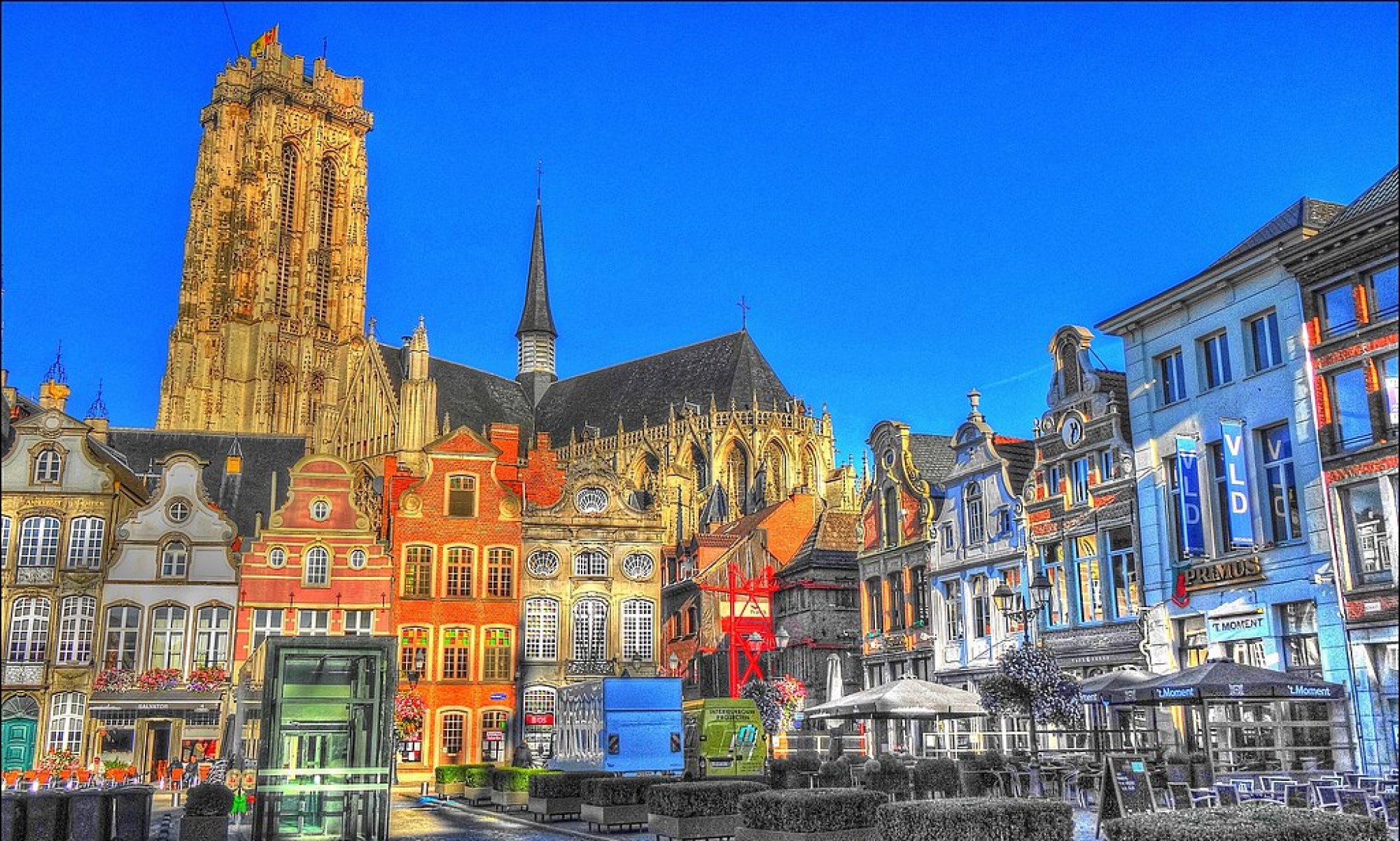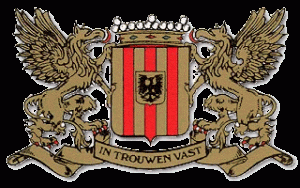Please note that the Dutch language version contains more information
Ancestors Toine Piscaer – text
Ancestors Toine Piscaer – graphical
Ancestors Berend Boneschansker IX – text
Ancestors Berend Boneschansker IX – graphical
Piscaer
Mechelen (Malines), The capital of the Netherlands under the dukes of Burgundy, has been the seat of the Supreme Council up to the 18th century, since 1559 seat of the archbishop, is located by the river Dijle in the Belgian province of Antwerp.
(The weapon of Mechelen)
It’s many monuments of history and art testify of its importance, of its prosperity and of its culture. During the Austrian reign is has been a garrison city with depots and gun foundries.
Since a long time the city was a centre of industry and shipping. The Malines lace had been famous. It’s chair makers carried the cities fame far outside the borders. Involved in these different branches of industry, was also the Piscaer family. In many different ways of spelling, we designate the name in the baptism registers of the catholic churches in the city, but mainly in those of ’the parish ‘, which is Saint Kathelijne, and Saint Rombout. Beside each other we find Picaer, Picaerts, Picar, Picard, Piccaert, Pichaer, Pisar, Piscael, Piscaer, Piscaert, Pischaer, Piscar, Piscarre, Piscart, Piscas, Pischeur and Piskhaer. On 13 April 1947 dr. Vaast Steurs of Mechelen wrote that the name Piscaer also is not entirely certain. One could retrieve it under different spellings which all have approximately the same pronouncement. At the end of the 16th century, one could for sure retrieve it under the form “Piscador” = fisherman. Others explain the origin of the name with the Czech word “Piscaero” = dagger. As such the name could already be found in the 13th century in Mechelen.
In the at that time dense populated districts of the city, next to the Begijnhof and between the Antwerpsestraat and the Kerkhofstraat (now G. the Strassaertstraat) the Saint Kathelijne parish was located. The locals simply called it ‘de parochie’( ‘ the parish ‘ ). Our earliest known ancestor, Joannes Piscart, had his firstborn daughter Anna baptized here in 1639. Next to Saint Kathelijne another parish Sint Jan (Saint John) was located. It stretched itselve on both sides of the Koestraat. The contrast between both districts was striking. Saint John’s parish was a distinguished district, with many Patricians houses. In Saint John’s Church Martinus, Maria and Cecilia were baptised, whereas the second son Joannes once again was baptized in Saint Kathelijne in 1646. In one of these two districts of the city Joannes Piscart probably must have resided. Considering that Mechelen was garrison city in the Austrian time, as stated before, it comes as no surprise that his son Joannes chose a military career. The baptism book of the Kathelijne calls him ‘ milis ‘ or ‘ Militis art.’ His friends, soldiers as well, witnessed the baptism of his children.
Some generations later find we the Piscaer family in the district around the river Dijle. Here many captains lived and dockers who found their existance in the activities of the Malines inland harbour. This port was favourable close to the aggregation of the Rupel, Nete and Dijle rivers. Especially freight transport with small ships was very important. Competition of freight transport by road or by rail had yet to come and the different water ways led into the heart of the Kempen, to Diest and to Herentals. They transported fish, grain, brick, wood, peat, and later coal and not to forget the well-known Malines chairs. Many chair maker families had also established their business in the direct surroundings of the Dijle. The required wood for their companies was transported by boat and the chairs also found their way along the same route to the consumers in their own districts and after 1814 also to the northern provinces. The chairs were not only manufactured for domestic use, but also the churches in those days were important consumers of this Malines product. It often must have been very busy loading and unloading the goods on the Dijle quays, as well as in the crowded streets and lanes which led to the river. Martinus Piscaer (born 1773) as well his brother Anthonius who lived at the Kattenberg, must has been involved in these activities. Both were boatman (batelier) who delivered the cargo trusted to their care to its destination with their own ships. Also Anthonius oldest son Martinus was trying his luck in the freight transport on the Dijle, while Pierre Joseph Jean, the second son, around 1850 took his family to the Netherlands, where he became the founder of the Dutch Piscaer family. On January 31, 1857 we find him in Amsterdam, where he reported the birth of its zoon Louis. We must, however, almost certain assume that economic reasons had been the main cause for his decision. The Belgian independence declaration with its long-term aftermath had brought no prosperity to Mechelen. On the contrary! Trade, industry and especially shipping had got a severe blow, since the important market in the north had been gone.
In their new fatherland Pierre and his sons, would quickly find their way. The inland shipping was in their blood and in Amsterdam the possibilities were endless. In 1851, After Den Helder by Royal Decree had been appointed to transhipment place, the sea ships no longer needed to pass through to Amsterdam, but could deliver their goods in Den Helder. For Amsterdam however it was of the largest importance that not too many ships would anchor in the Nieuwediep. A towing service provided the best solution to drag the ships in a relatively short time through the Noordhollands canal to Amsterdam. In 1857, Mr. De Haas and Mr. Boelen applied for a permit to open a towing service and a year later already, they maintained a service between the IJ and the Nieuwediep with six ships. They were called ‘ Amsterdam ‘, ‘ Alkmaar ‘, ‘ Nieuwediep ‘, ‘ Haarlem ‘, ‘ Purmerend ‘ and ‘ ‘ t Zand. On of these ships Pierre Joseph Jean Piscaer has sailed as captain and therefore around 1858, he moved to Den Helder, where on June 10, 1859 his youngest daughter Alida Maria was born. Meanwhile the Goedkoop brothers had also received authorisation to maintain a towing service on Den Helder and the Nieuwediep. Under the name “Noord-Holland” they started with three steamtowboats and put up a heavy competition fight against ‘deHaas & Boelen’. In 1868, the latter were forced to end their line on the Noordhollands canal. In the same year Goedkoop introduced the Noordholland 4 and 5 and in finally 1869, the Noordholland 6 and 7. At some time Pierre Piscaer apparently had more trust in a contract with Goedkoop. At the silver marriage jubilee of one of the brothers, Mr. P. Goedkoop, on May 23, 1869 Pierre and his sons Peter, Martin and Jan signed a register which was offered to the jubilaresse. In 1895, in such a register, only the eldest son Peter is listed as captain of the Noordholland 7.
author: M.M.J. Hoogenbosch
August 1980 in “Het Geslacht Piscaer”
translation: Toine Piscaer

